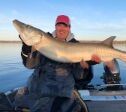- 0



By SkunkedAgain · Posted



By CigarGuy · Posted
.thumb.jpg.5c1a86e9339e49e53f5bfefed2220054.jpg)
By LakeofthewoodsMN · Posted

By Brianf. · Posted
By using this site, you agree to our Terms of Use and Privacy Policy. We have placed cookies on your device to help make this website better. You can adjust your cookie settings, otherwise we'll assume you're okay to continue.

Question
Jeremy airjer W
What happens to a fuel pump when it fails? The most common failure I see is that the commutator has worn out. This would be followed by electrical failure, mechanical/undetermined failure, and lastly worn out brushes. This is a long read but it does have pictures which always make a long read better!
A worn out commutator usually shows up after you turn off the vehicle and try to restart it. In some cases it becomes completely worn out and will cause the vehicle to stall. The commutator is the part of the pump that the brushes make contact with to deliver current to the windings.
Next is electrical failure in some form. This is especially true with GM vehicles and especially the trucks and SUV’s. The most common is the burnt up pins inside of the connectors that deliver power to the fuel pump/module assembly.
It’s usually pretty obvious. Just look for the black or heavily discolored pins on both sides of the connections. If it’s present it will need to be replaced. On the older pickups/SUV’s with the metal sending unit it was really common to see the pins burnt up in the connector on the inside of the tank. GM has finally started to update the harness to the pump and the connector on top of the pump on a few vehicles. A common symptom with these failures is stalling and then restarting after cooling down for a bit or just stalling all together and not restarting.
Next we have mechanical or undetermined failures. I would put most fords into this category. These are the least likely to restart after a failure. Most of the pumps I see are out of the Taurus and Contours.
As you can see by the melted insulation there’s no way for the motor to spin anymore. You can hit this one as long as you like and it won’t go! I haven’t figured out why exactly they do this but every one of them either looks like this or it looks like brand new. The ones that do look like brand new seem to have a lot of debris inside of the housings that the pump sits in. I haven’t figured out where this comes from either. These are in the unknown category. Thankfully they are a rare find and always make me think did I fix what really needed to be fixed?
And lastly there are worn out brushes.
It’s pretty unusual to see one but it does happen. Typically one brush will be like brand new and the other will be completely worn out. Every once and a while both will be worn out. These sometimes will respond to a whack on the tank as well.
What causes all these things to occur? That I couldn’t give any definitive answer but I can tell you that just about every fuel pump I install has a plugged fuel filter. I am positive that changing fuel filters regularly makes a huge difference in prolonging the life of a pump. Case in point this last winter I towed in a Chevy p/u. It had over 180,000. It stalled on the freeway. I was talking to the guy about what could be wrong and mentioned that he was probably do for his second fuel pump. He replied that he hasn’t replaced the first one yet. After some further conversation it turns out he was very prudent at changing filters and especially the fuel filter. As it turned out the pump was bad and if I remember right the commutator was worn out but the filter had no restriction. This guy got an extra 100k out of a pump by changing filters!
So how did I figure all this out? Well I was working for the city of Maplewood for a while and it seemed like we where always replacing pumps on the caprices seemed like around every 40k. My natural curiosity wanted to find out why so I started tearing apart every one of the pumps I replaced. All the pumps we replaced had worn out commutators. Then it dawned on me these cars run 24/7 so the pump runs all the time which makes them wear out that much faster. After that I have torn apart every pump I have replaced over the last 8 or 9 years to see what happened.
Link to comment
Share on other sites
4 answers to this question
Recommended Posts